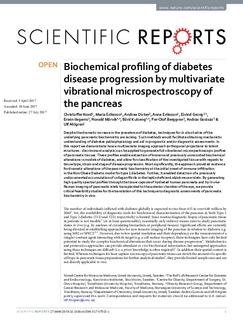| dc.contributor.author | Nord, Christoffer | |
| dc.contributor.author | Eriksson, Maria | |
| dc.contributor.author | Dicker, Andrea | |
| dc.contributor.author | Eriksson, Anna | |
| dc.contributor.author | Grong, Eivind | |
| dc.contributor.author | Ilegems, Erwin | |
| dc.contributor.author | Mårvik, Ronald | |
| dc.contributor.author | Kulseng, Bård Eirik | |
| dc.contributor.author | Berggren, Per-Olof | |
| dc.contributor.author | Gorzsás, András | |
| dc.contributor.author | Ahlgren, Ulf | |
| dc.date.accessioned | 2018-07-03T09:42:50Z | |
| dc.date.available | 2018-07-03T09:42:50Z | |
| dc.date.created | 2017-12-12T17:05:05Z | |
| dc.date.issued | 2017 | |
| dc.identifier.citation | Scientific Reports. 2017, 7:6646, 1-12. | nb_NO |
| dc.identifier.issn | 2045-2322 | |
| dc.identifier.uri | http://hdl.handle.net/11250/2504128 | |
| dc.description.abstract | Despite the dramatic increase in the prevalence of diabetes, techniques for in situ studies of the underlying pancreatic biochemistry are lacking. Such methods would facilitate obtaining mechanistic understanding of diabetes pathophysiology and aid in prognostic and/or diagnostic assessments. In this report we demonstrate how a multivariate imaging approach (orthogonal projections to latent structures - discriminant analysis) can be applied to generate full vibrational microspectroscopic profiles of pancreatic tissues. These profiles enable extraction of known and previously unrecorded biochemical alterations in models of diabetes, and allow for classification of the investigated tissue with regards to tissue type, strain and stage of disease progression. Most significantly, the approach provided evidence for dramatic alterations of the pancreatic biochemistry at the initial onset of immune-infiltration in the Non Obese Diabetic model for type 1 diabetes. Further, it enabled detection of a previously undocumented accumulation of collagen fibrils in the leptin deficient ob/ob mouse islets. By generating high quality spectral profiles through the tissue capsule of hydrated human pancreata and by in vivo Raman imaging of pancreatic islets transplanted to the anterior chamber of the eye, we provide critical feasibility studies for the translation of this technique to diagnostic assessments of pancreatic biochemistry in vivo. | nb_NO |
| dc.language.iso | eng | nb_NO |
| dc.publisher | Nature Publishing Group | nb_NO |
| dc.rights | Navngivelse 4.0 Internasjonal | * |
| dc.rights.uri | http://creativecommons.org/licenses/by/4.0/deed.no | * |
| dc.title | Biochemical profiling of diabetes disease progression by multivariate vibrational microspectroscopy of the pancreas | nb_NO |
| dc.type | Journal article | nb_NO |
| dc.type | Peer reviewed | nb_NO |
| dc.description.version | publishedVersion | nb_NO |
| dc.source.pagenumber | 1-12 | nb_NO |
| dc.source.volume | 7:6646 | nb_NO |
| dc.source.journal | Scientific Reports | nb_NO |
| dc.identifier.doi | 10.1038/s41598-017-07015-z | |
| dc.identifier.cristin | 1526445 | |
| dc.description.localcode | © Te Author(s) 2017. This article is licensed under a Creative Commons Attribution 4.0 International License, which permits use, sharing, adaptation, distribution and reproduction in any medium or format, as long as you give appropriate credit to the original author(s) and the source, provide a link to the Creative Commons license, and indicate if changes were made. Te images or other third party material in this article are included in the article’s Creative Commons license, unless indicated otherwise in a credit line to the material. | nb_NO |
| cristin.unitcode | 194,65,15,0 | |
| cristin.unitname | Institutt for klinisk og molekylær medisin | |
| cristin.ispublished | true | |
| cristin.fulltext | original | |
| cristin.qualitycode | 1 | |

